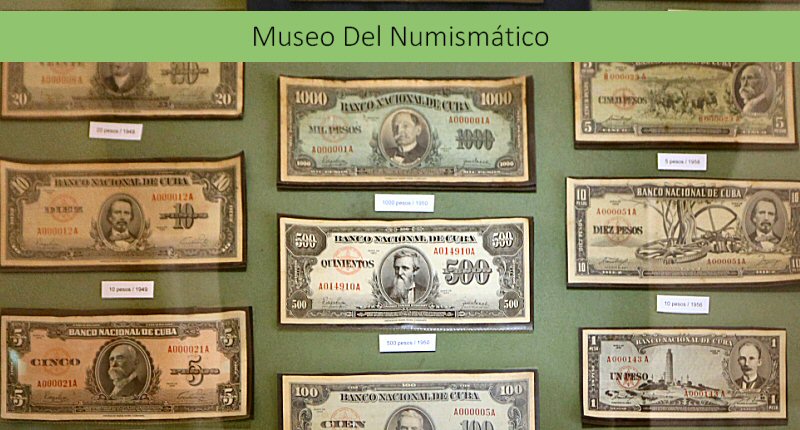
The Museo Del Numismático is located on
the Obispo street #305, between the
Aguiar and the Habana streets.
The Museo Del Numismático was
established on the initiative of Raúl León Torras
(1935-1985), President of the National Bank of Cuba, as a
cultural institution in 1975. Its establishment bases on the
resolution No. 151 of the National Bank of Cuba.
Initially, the museum was
inaugurated in the building of the Banco Gelats y Cía that
was located on the Aguiar street #456, between the
Lamparilla and the Amargura streets. Currently, this
building houses the Banco Nacional de Cuba. In 1984, the
museum moved to another building on the Oficios street #8,
between the Obispo and the Obrapia streets, that served as
the Episcopal Palace from 1610 to 1858, and a few years
later (1844) became Monte de Piedad (today
Coin Museum).
In 2000 the museum moved
to its current localization on the Obispo street #305,
between the Aguiar and the Habana streets, that was the
headquarter of the Banco Mendoza at the beginning of the
20th century. Mendoza Company was exporting sugar and
securities, as well purchasing and selling real estate. It
was the first bank in the forming bank district, enclosed
by the O’Reilly, the Amargura, the Compostela and the
Mercaderes streets, that would realize the most important
transactions in the country.
Numismatics is the study or
collection of currency, including coins, tokens, banknotes,
and related objects. The word numismatics takes its origin
from the Greek word νόμισμα (read as nomisma), a term used
to designate any small metal piece used as payment media in
commercial transactions. The first coin was minted in Sardes,
the capital of the ancient Lydia in Asia Minor (Anatolia),
around the 7th century; consequently, this ancient city was
the first that had a mint.
The Museo
Del Numismático is the only museum on the world that is
dedicated exclusively to the exhibition of the types of
money and its substitutes. The collection of the museum
includes more than 160.000 pieces from all over the world.
Among the 1.500 the pieces that are exhibited in the
showcases of the permanent exhibition rooms, coins and
banknotes that circulated in Cuba in
the first twenty years of the last century, are in the
majority, but there are also medals, vouchers that were
given in the sugar mills as money substitute, bond
certificates, lottery tickets and counterfeits cought in the
country.
The building of the museum
was built in 1915. Its façade has an excellent architectural
design composed of four thick columns. The museum has
three exhibition rooms, a documentation center and a library.
One of the rooms is dedicated to the exhibitions with the
themes of numismatics. This room provides also the
possibility for private collectors to exhibit their
collections. Additionally, specific dates of numismatics are
celebrated in this room.
The second room is
dedicated to the medals (Sala Medallística).
The room is arranged by historical stages, from the
time of the city hall up to the revolution.
The third room is
dedicated to the circulated money types (Sala de Circulación
Monetaria). The collection covers about
thousand coins made of gold that date back to the period
between 1860 and 1928, and an almost complete chronology of
Cuban tickets from the 19th century until today. These
unique tickets of which today there are no more than four or
five copies, are appreciable historical importance.
Likewise, the 20 pesos coin that is the only one still
existing of the ten produced, should be not missed.
The coins and the tickets are arranged
according to their historical stages, from the appearance of the
currency in the seventh century up to the current currency.
The visitor receives enough knowledge about the historical
development of the currency in Cuba, following the coins in
the showcases, such as the first coins minted by the order
of the Catholic Monarchs in the American mints and the gold
US coins. When the Casa de la Moneda de Cuba (Mint of Cuba)
was inaugurated in 1977, three gold 100 pesos coins with the
portrait of Céspedes were minted. These coins are exhibited
under the headline Grandes Eventos de la Historia de Cuba
(Major Events in the History of Cuba).
The museum
has an exceptional collection of banknotes, including a
series of 1.000 pesos signed by Carlos Manuel de Céspedes,
the first president of the Republic Army, in 1869. Céspedes
always wanted that the Republic would have its own money.
Therefore, the first Cuban banknotes bear his signature.
In some showcases there are also
banknotes issued more than a century ago by the Cuban
revolutionary troops that were destined to circulate in the
territory where they were operating.
The value of the
exhibits is estimated to be about 50 million dollars.
The library that has a large number
of catalogs, is located downstairs and was named after Raúl
León Torras (1935-1985) that had a great effort in the
establishment of the numismatic museum.
The institution provides
specialized library services, expert appraisals, and guided
visits.

